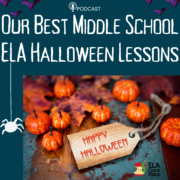How we started to use Bingo cards in Our ELA Classrooms
In an effort to find a fun way to encourage students to read, we started using an ongoing Bingo game for novels. We used these cards for student’s independent novel choices and book club books. The Bingo charts were such a hit that we started using them for our vocabulary words and for Greek and Latin roots too! We are excited to tell you all about how it works!
Fun!
Now, we all know why BINGO cards work. Let’s face it, middle school kids love prizes. Some of our favorites to use in class are candy, stickers, and unique pens and pencils!
We’ve found that on Amazon, you can order packs of stickers that don’t cost too much. We order the kind that can be put on water bottles or phones or laptops. Kids love them! We put up a pocket chart to display these stickers, and some kids would rather have one of these than candy.
Here is how the Bingo cards work. Each student is given a card. The cards have statements that require students to find certain sections, characters, connections, or literary devices in their reading. For example, one square may say, “Find a section of the novel that has a flashback.” So, as students are reading, if they notice a flashback, they go to that bingo square for flashback and record the page number and the first few words of the flashback.
If that section of the book is being discussed in class or in a small group for book clubs, the student can bring up the flashback and the group or the class can discuss what the flashback means and why it was important. When a student has filled in five squares in a row, they of course have BINGO, and they receive a prize! That keeps them motivated and engaged.
Now We Add Vocabulary Bingo Cards!
Students loved the novel bingo cards so much, we decided to try BINGO cards with our vocabulary words. The vocabulary Bingo card can be used with any vocabulary word list. Each block on the card has two letters of the alphabet. The first box has letters a and b, the second block has letters c and d, and so on. All of the letters are repeated on the squares once. Students fill in words that they see in their independent reading. They also record words they hear a teacher say or words they correctly use in their speaking or writing. They must write the words in the box that has the letter that the vocabulary word begins with. So if one of their words is disdain, they will write that word in the box with the letters c or d. To document, students must do the following.
- For a word that they see in a book, they must record the page number and title of the book.
- For a word that they hear a teacher say, they must get the signature of that teacher on the square that has that particular word.
- Also, the student should write the sentence in which the word was used. For this, students will need to use the back of the card for the sentence documentation.
And, like with the book club bingo cards, when students get five in a row, they earn a prize! We also do one bonus point on a vocabulary test along the way. They show us the card and we initial and add the point on the next test.
We would like to give you these vocabulary bingo cards free of charge! Click here for the free cards in our TPT store!
The Vocabulary Curriculum We Use
The two main things we incorporate into our vocabulary curriculum are repetition and mnemonic devices.
Way back in 2006, we created a bell ringer called Daily Dose. Since then, we have changed, updated, and improved it. What makes this resource so successful is that it contains a word of the day that is accompanied by a funny mnemonic story. This is what ensures that kids remember the word. We swear by our silly mnemonic stories that accompany our vocabulary words! We have both had students whom we taught 20 years ago tell us that they still remember words and the silly story that goes with them. “Mrs. Temple, I remember that word smug and how that man was so caught up on himself and smug that he put his face on all of his mugs.”
The other component to a successful vocabulary component is repetition. In our Daily Dose bell ringer, there are 90 words for the first ninety days of school. Then the remaining 90 days are spent reviewing the 90 we’ve already learned. There is no sense in piling on 20 vocabulary words a week for students to memorize for a test and then forget. If your students can walk away from your class at the end of the year truly owning 30-40 new vocabulary words, that is astounding.
Each and every Daily Dose bell ringer provides a word, a mnemonic, the word in context, along with editing questions and a standards based question.
Recently, we created a new 8th grade vocabulary words of the week resource, and unlike Daily Dose, it is not a bell ringer. But it still has the silly mnemonic stories and repetition.
We have recently started using the Bingo card game with these vocabulary programs. Our students enjoy this added component!
Below you will find the links to these vocabulary resources in our TPT store. If you don’t already have a vocabulary program that you like, you can try out one of ours!
6th Grade Daily Dose – Click on the Preview button for a sample!
7th Grade Daily Dose – Click the Preview button for the sample!
8th Grade Daily Dose – Click the green Preview button for the sample!
8th Grade Vocabulary Word of the Week






